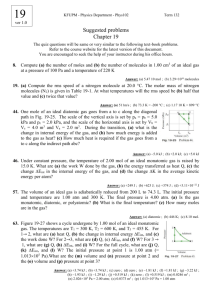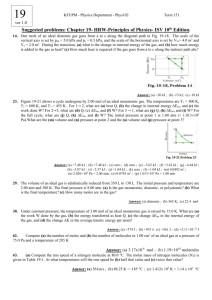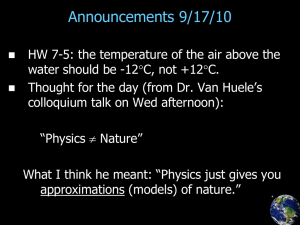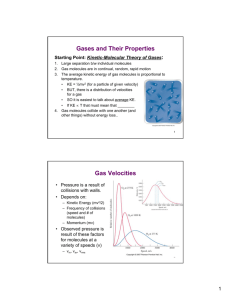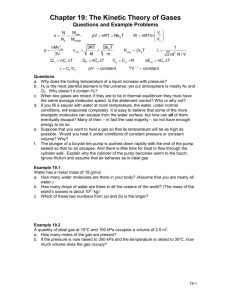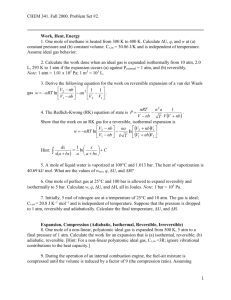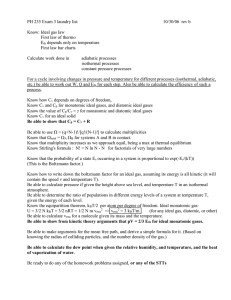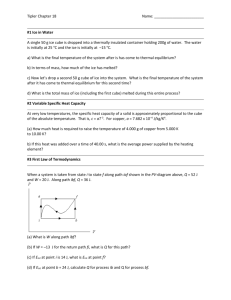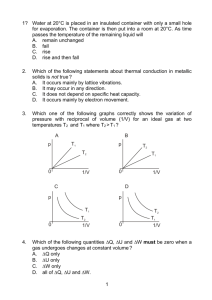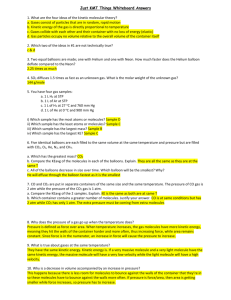Problem Set 2 - Cabrillo College
advertisement
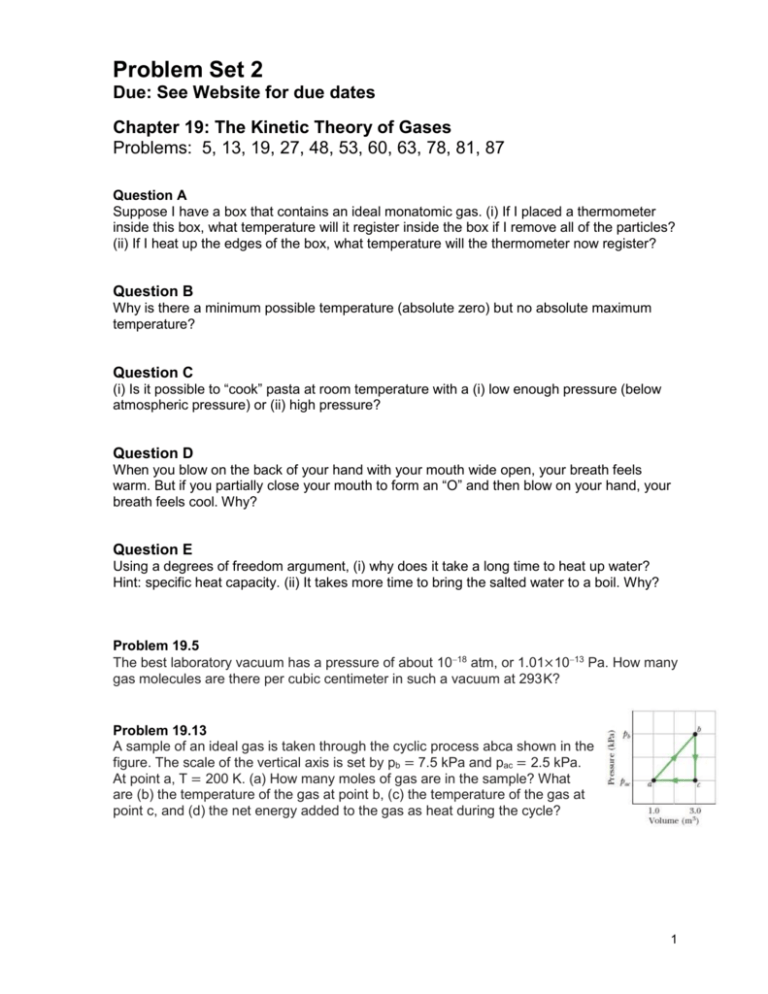
Problem Set 2 Due: See Website for due dates Chapter 19: The Kinetic Theory of Gases Problems: 5, 13, 19, 27, 48, 53, 60, 63, 78, 81, 87 Question A Suppose I have a box that contains an ideal monatomic gas. (i) If I placed a thermometer inside this box, what temperature will it register inside the box if I remove all of the particles? (ii) If I heat up the edges of the box, what temperature will the thermometer now register? Question B Why is there a minimum possible temperature (absolute zero) but no absolute maximum temperature? Question C (i) Is it possible to “cook” pasta at room temperature with a (i) low enough pressure (below atmospheric pressure) or (ii) high pressure? Question D When you blow on the back of your hand with your mouth wide open, your breath feels warm. But if you partially close your mouth to form an “O” and then blow on your hand, your breath feels cool. Why? Question E Using a degrees of freedom argument, (i) why does it take a long time to heat up water? Hint: specific heat capacity. (ii) It takes more time to bring the salted water to a boil. Why? Problem 19.5 The best laboratory vacuum has a pressure of about 1018 atm, or 1.01×1013 Pa. How many gas molecules are there per cubic centimeter in such a vacuum at 293 K? Problem 19.13 A sample of an ideal gas is taken through the cyclic process abca shown in the figure. The scale of the vertical axis is set by pb = 7.5 kPa and pac = 2.5 kPa. At point a, T = 200 K. (a) How many moles of gas are in the sample? What are (b) the temperature of the gas at point b, (c) the temperature of the gas at point c, and (d) the net energy added to the gas as heat during the cycle? 1 Problem 19.19 (a) Compute the rms speed of a nitrogen molecule at 20.0°C. The molar mass of nitrogen molecules (N2) is given in Table 19-1. At what temperatures will the rms speed of the nitrogen molecules be (b) half that value and (c) twice that value? Problem 19.27 Water standing in the open at 32.0°C evaporates because of the escape of some of the surface molecules. The heat of vaporization (539 cal/g) is approximately equal to εn, where ε is the average energy of the escaping molecules and n is the number of molecules per gram. (a) Find ε. (b) What is the ratio of ε to the average kinetic energy of H2O molecules, assuming the latter is related to temperature in the same way as it is for gases? Problem 19.48 When 20.9 J was added as heat to a particular ideal gas, the volume of the gas changed from 50.0 cm3 to 100 cm3 while the pressure remained at 1.00 atm. (a) By how much did the internal energy of the gas change? If the quantity of gas present was 2.00×103 mol, find (b) Cp and (c) CV. Problem 19.53 Suppose 4.00 mol of an ideal diatomic gas, with molecular rotation but not oscillation, experienced a temperature increase of 60.0 K under constant-pressure conditions. What are (a) the energy transferred as heat Q, (b) the change ∆Eint in internal energy of the gas, (c) the work W done by the gas, and (d) the change ∆K in the total translational kinetic energy of the gas? Problem 19.60 Adiabatic wind: The normal airflow over the Rocky Mountains is west to east. The air loses much of its moisture content and is chilled as it climbs the western side of the mountains. When it descends on the eastern side, the increase in pressure toward lower altitudes causes the temperature to increase. The flow, then called a chinook wind, can rapidly raise the air temperature at the base of the mountains. Assume that the air pressure p depends on altitude y according to p = p0eay, where p0 =1.00 atm and a =1.16 ×104 m1. Also assume that the ratio of the molar specific heats is γ = 4/3. A parcel of air with an initial temperature of −5 .00°C descends adiabatically from y1 = 4267 m to y =1567 m. What is its temperature at the end of the descent? 2 Problem 19.63 The figure shows a cycle undergone by 1.00 mol of an ideal monatomic gas. The temperatures are T1 = 300 K, T2 = 600 K, and T3 = 455 K. For 1→2, what are (a) heat Q, (b) the change in internal energy ∆Eint, and (c) the work done W? For 2→3, what are (d) Q, (e) ∆Eint, and (f) W? For 3→1, what are (g) Q, (h) ∆Eint, and (i) W? For the full cycle, what are (j) Q, (k) ∆Eint, and (l) W? The initial pressure at point 1 is 1.00 atm (= 1.013×105 Pa).What are the (m) volume and (n) pressure at point 2 and the (o) volume and (p) pressure at point 3? Problem 19.78 (a) An ideal gas initially at pressure p0 undergoes a free expansion until its volume is 3.00 times its initial volume. What then is the ratio of its pressure to p0? (b) The gas is next slowly and adiabatically compressed back to its original volume. The pressure after compression is (3.00)1/3p0. Is the gas monatomic, diatomic, or polyatomic? (c) What is the ratio of the average kinetic energy per molecule in this final state to that in the initial state? Problem 19.81 An ideal gas is taken through a complete cycle in three steps: adiabatic expansion with work equal to 125 J, isothermal contraction at 325 K, and increase in pressure at constant volume. (a) Draw a pV-diagram for the three steps. (b) How much energy is transferred as heat in step 3, and (c) is it transferred to or from the gas? Problem 19.87 The figure shows a cycle consisting of five paths: AB is isothermal at 300 K, BC is adiabatic with work = 5.0 J, CD is at a constant pressure of 5 atm, DE is isothermal, and EA is adiabatic with a change in internal energy of 8.0 J. What is the change in internal energy of the gas along path CD? 3
